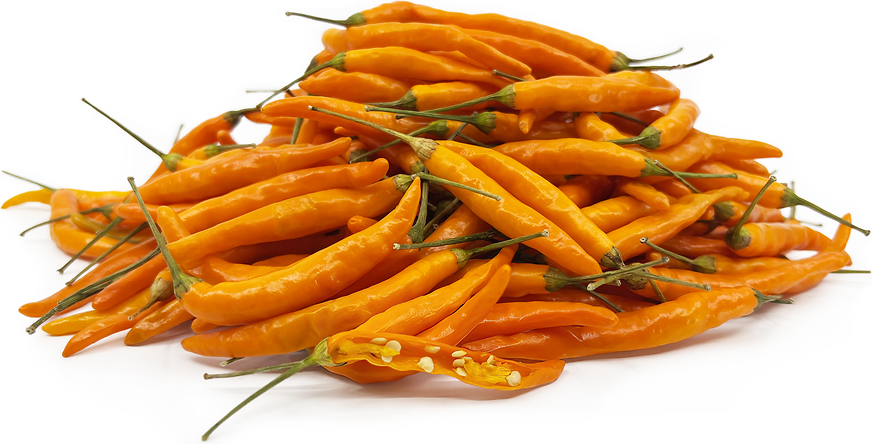


Orange Thai Chile Peppers
Estimated Inventory, lb : 0
Description/Taste
Orange Thai chile peppers are slender, curved to straight pods, averaging 5 to 8 centimeters in length, and have a conical shape tapering to a point on the non-stem end. The skin is smooth, taut, and waxy, ripening from dark green to orange when mature. Underneath the surface, the flesh is thin, crisp, aqueous, and orange, encasing a central cavity filled with membranes and small, round, and flat cream-colored seeds. Orange Thai chile peppers have a fruity, subtly sweet flavor followed by an immediate heat that lingers on the palate.
Seasons/Availability
Orange Thai chile peppers are available in the late summer through fall.
Current Facts
Orange Thai chile peppers, botanically classified as Capsicum annuum, are a brightly colored variety that belongs to the Solanaceae or nightshade family. Also known as Prik Leung, which translates from Thai to mean “orange chile,” Orange Thai chile peppers have a moderate heat ranging from 50,000-100,000 SHU on the Scoville scale. Orange Thai chile peppers are used similarly to red and green Thai chile peppers and are often substituted for red peppers in both raw and cooked applications. Though the peppers are favored for their bright coloring, they are only seasonal in local markets and are commonly grown as a specialty variety in home gardens. Orange Thai chile pepper plants are praised for their high yields, compact size, ornamental nature, and the pod’s heat is favored for everyday use in sauces, pastes, and main dishes.
Nutritional Value
Orange Thai chile peppers are a good source of vitamins A and C, which are antioxidants that can boost the immune system, increase collagen production, and help prevent vision loss. The peppers also contain fiber, copper, potassium, magnesium, iron, vitamins B6 and K, and capsaicin, which is a chemical compound that triggers the brain to feel the sensation of heat or spice. Capsaicin has been shown to provide anti-inflammatory benefits.
Applications
Orange Thai chile peppers are best suited for both raw and cooked applications such as stir-frying, boiling, and sautéing. The brightly colored peppers are most popularly ground into pastes, minced into marinades and sauces, or are chopped into salsas for added flavoring. They can also be sliced into salads, mixed into noodle and rice dishes, diced and baked into bread or biscuits, cooked into omelets, or stirred into soups and curries. In Thailand, Orange Thai chile peppers are incorporated into yellow curries and sour curries, often cooked with ingredients such as fish and turmeric, and the small peppers can also be dried and ground into a powder for use as a seasoning. Orange Thai chile peppers pair well with zucchini, summer squash, eggplant, green beans, bok choy, celery, carrot, bell pepper, bamboo shoots, pineapple, peanuts, lime juice, coconut milk, seafood, and meats such as poultry, beef, and fish. The fresh peppers will keep up to two weeks when stored whole and unwashed in the crisper drawer of the refrigerator.
Ethnic/Cultural Info
In Thailand, Orange Thai chile peppers are viewed and used similarly to the common red Thai chile pepper, displayed in large, brightly colored mounds at the local markets. The vibrant-hued peppers are primarily used in the dish pad phet, which is pronounced “pad pet.” Pad phet is a stir-fry that uses red curry paste, Orange Thai chile peppers, and a variety of protein and vegetables to make a sweet, savory, and spicy curry. Pad phet is commonly made in home cooking and is considered an easy, comforting dish that can help use up excess ingredients found in the kitchen. In addition to curries, Orange Thai chiles are often seen in condiments and dipping sauces that can be added to almost any dish to help provide extra heat and fruity flavors. Spicy condiments are often present on Thai restaurant tables as well as utilized at home.
Geography/History
Orange Thai chile peppers are descendants of spicy peppers native to South America that have been growing wild since ancient times. The original pepper varieties were introduced to Southeast Asia in the 15th and 16th centuries via Portuguese explorers, and since their introduction, the peppers have been selectively bred over generations to create many of the varieties that are labeled as Thai chile peppers today. Out of all the Thai varieties, Orange Thai chile peppers are considered to be one of the rarer varieties that is predominately grown as a specialty variety in home gardens. The peppers can be found when in season at local markets across Thailand, but outside of Thailand, the variety is sold through online seed catalogs for home garden use in North America, Australia, and Europe.




